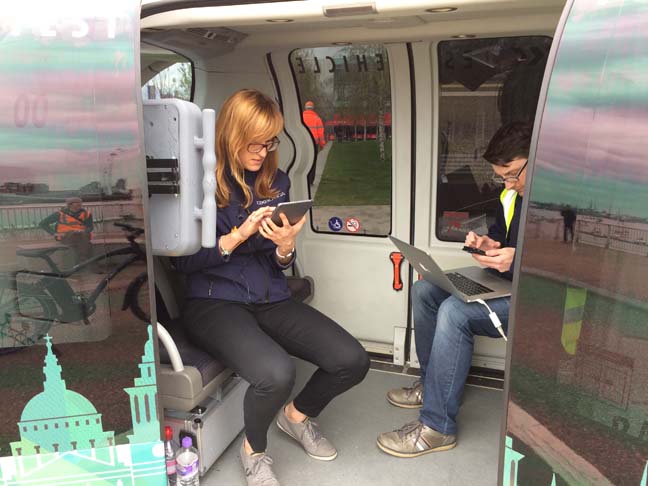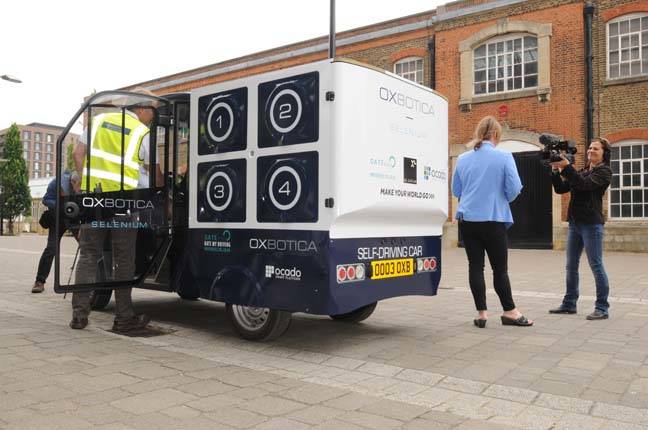This article is more than 1 year old
Autonomous driving in a city? We're '95% of the way there'
Goal is 'Level 5', where vehicle reacts like human-driven one
What self-driving technology should you bet on?
If autonomous vehicles are just computers on wheels, and if they follow the history of the computer industry, expect consolidation and shakeout.
Detecting a winner in this Kitty Hawk throng will be difficult. While first to powered flight, the Wright brothers failed to make a commercial success of their pioneering work. Timber company executive William Boeing, meanwhile, was so captivated by the sight of a flying machine in 1909 that he founded the Boeing Company in 1916, which proceeded to dominate civilian and military aircraft manufacturing.
Back on the ground and in the present day, the number of companies authorized to test autonomous vehicles in California, home of Silicon Valley, is today numbered at 36 – up from 11 last year.
That list is comprised of carmakers, component manufacturers and tech firms – from chips to online search and smart phones.
In the UK, the British government last year gave its blessing to eight projects working on a number of aspects – vehicle systems, testing tools, user acceptance and hardware – to retrieve and analyse vehicle data supposedly in real-time.
The Royal Borough of Greenwich is home to two autonomous vehicle pilots: GATEway, an £8m project dating from October 2015, and MOVE‑UK, a three-year project that’s part of the UK government’s £20m series of announcements last year.
MOVE-UK hasn’t revealed much of its technology, but the project is looking at data: devices mounted on five council-owned Land Rover Discoveries are capturing data on how the driver responded and how the autonomous vehicle would have acted.
In such a competitive environment, Oxbotica is coy about detailing its technology, although it claims 85 pieces of Intellectual Property in its Selenium self-driving system, which it licenses whole or in part to tier-one automakers.
CargoPod, which uses Selenium, employs a visual rather than GPS navigation: a series of images are compared to incoming video streams from cameras on the van for orientation. Oxbotica eschewed GPS, saying it means they aren’t dependent on third-party map providers.
Image processing is performed on what Oxbotica called a “high-end, off-the-shelf” laptop running an Intel Xeon 12‑core processor and Ubuntu Linux. Selenium is written in C/C++ and is platform agnostic, Oxbotica says.
Stepping out from the UK you have Nvidia, which is pushing a GPU stack and rallying vehicle makers against PC chip giant, Intel. Nvidia’s Drive PX uses its Tegra Systems on a Chip with up to eight Cortex cores and 512 CUDA cores. The software is Nvidia’s written using C/C++ and using GPU-accelerated Deep Learning SDKs for Caffe, CNTK, TensorFlow, Theano, and Torch. Nvidia has an impressive number of carmakers including Toyota, Volvo, Tesla, Audi, Mercedes-Benz and car systems maker Bosch – that’s part of DRIVE‑UK with Jaguar Land Rover.

Which autonomous vehicle platform would you choose? (Photo by Oxbotica)
Intel has been working with BMW and Delphi and spent $15bn this year on Mobileye, developing vision-based driver assistance. Waymo has partnered with Fiat Chrysler on a minivan. Waymo employs LiDAR and RADAR.
The situation is therefore risky for early movers, choosing which self-driving platform they should bet on, says Canalys’ Cox. “If we get to the point where Waymo is productized and proves to be more advanced than what other companies are capable of doing, it might be waste of investment for those companies,” he said.
What about the public? The public wants a lot...
Another factor that will decide winners and losers will be government. As officials inevitably set standards, those who fall below the bar will be forced to withdraw.
“The odds are quite long on all the horses at the moment, but who knows how it will pan out? There will be consolidation when there’s regulation, when legislators apply standards around performance of your technology,” Reed said.
Ultimately, however, there’s a bigger concern for Reed: backlash. Or, the public’s expectations are not met by what’s being promised, by the tech consortia behind autonomous vehicles and the breathless media reporting on them. There is a risk that driverless vehicles will plough head-first into a Gartner-esque trough of disillusionment before their wheels really hit the road.
“I think there’s a lot of momentum and a number of projects are making predictions and targets around certain dates. If those dates are missed and if expectations aren’t met – if the technology doesn’t deliver in some way what was promised – that will definitely lead to a backlash,” Reed said.
Integral to avoiding that backlash, therefore, is ensuring the autonomous vehicles drive goes beyond pure technology – it must work with and for people, too. It’s not a world away from the world of classic enterprise tech: designing and delivering a system users not only need but can use easily and without hurdles. Too much software failed in this, thereby earning enterprise software a hated reputation. It's expected the self-driving rollouts will be slow-moving shuttle craft that serve campus-like environments.
A detailed TRL whitepaper (here: PDF) in July expressed concern over what it called a “strong technology push for autonomous vehicles rather than a societal pull”. The report noted: “The potential benefits will only be delivered if users’ needs are catered for and society accepts and adopts automated vehicles.”
Ocado’s chief technology officer, Paul Clarke, accepts that hurdles exist, but sees the potential. “These things do get over-promised at times, but that’s why we are working with Oxbotica, a leader in their field,” Clarke said.

But can it deliver? Media hype plus a tech-only focus could damage driverless’ chances before it’s delivered. Pic: Gavin Clarke
For Ocado, success would mean another feature for OSP, for its own use – driverless warehouse vehicles and driverless deliveries – and for corporate customers.
Ocado’s goal is to sell the OSP infrastructure to other supermarkets – so far, it has just two: Morrisons Online and another, unnamed, European supermarket.
The firm built OSP when it started in 2000 because the systems of the day weren’t geared for a pure-play grocery retailer: they employed forecasting algorithms geared more to traditional brick-and-mortar businesses rather than an online firm generating and dicing lots of data.
“The fact we are trying this [self-driving] shows the depth of our technological ambitions, because we are a blend of a retailer and a technology business,” Clarke said. ®
